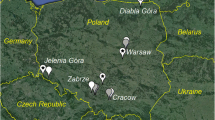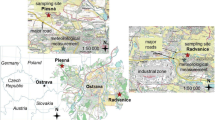Abstract
To elucidate the sources of PM10 air pollution from the experimental information collected in a local air quality monitoring campaign we have applied two methods, effective variance and genetic algorithms, in the solution of the chemical mass balance. The comparison of these two mathematical approaches show that the identification of the possible sources and the evaluation of its contributions are quite independent of them. The role of possible different sources for major and trace elements and the significance of standardizing available data is also addressed. We also present a simple method for identifying the number of candidate sources, a key element defining the dimension of the search space.
Similar content being viewed by others
References
Berthold, M., & Hand, D. (2003). Intelligent data analysis (2nd ed.). Berlin: Springer.
Bogo, H., Gómez, D., Reich, S., Negri, M., & San Román, E. (2001). Traffic pollution in a downtown site of Buenos Aires City. Atmospheric Environment, 35, 1717–1729. doi:10.1016/S1352-2310(00)00555-0.
Bogo, H., Otero, M., Castro, P., Ozafran, M., Kreiner, A., Calvo, E., et al. (2003). Study of atmospheric particulate matter in Buenos Aires City. Atmospheric Environment, 37, 1135–1147. doi:10.1016/S1352-2310(02)00977-9.
Cartwright, H., & Harris, S. (1993). Analysis of the distribution of airborne pollution using genetic algorithms. Atmospheric Environment, 27, 1783–1791.
Falcón, Y., García, R., Granados, M., & Palomero, M. (1993). Respirable particles and ozone concentrations measured inside an office in Mexico City. Journal of Aerosol Science, 24(Supplement 1), S437–S438. doi:10.1016/0021-8502(93)90311-V.
Friedlander, S. K. (1973). Chemical element balances and identification of air pollution sources. Environmental Science & Technology, 7, 235–240. doi:10.1021/es60075a005.
Goméz, D., Giné, M., Sánchez, A., & Smichowski, P. (2005). Antimony: A traffic-related element in the atmosphere of Buenos Aires, Argentina. Journal of Environmental Monitoring, 7, 1162–1168. doi:10.1039/b508609d.
Goméz, D., Reich, S., Dawidowski, L., & Vázquez, C. (2004). A combined analysis to identify airborne PM10 sources. Journal of Environmental Monitoring, 6, 1–10. doi:10.1039/b309380h.
Greenberg, H. J. (1995). Mathematical programming models for environmental quality control. Operations Research, 43, 578–622.
Haupt, R. L., & Haupt, S. E. (2002). Practical genetic algorithms. New York: Wiley.
Henry, R. C. (1997). History and fundamentals of multivariate air quality receptor models. Chemometrics and Intelligent Laboratory Systems, 37, 37–42. doi:10.1016/S0169-7439(96)00048-2.
Henry, R. C. (2002). Multivariate receptor models—current practice and future trends. Chemometrics and Intelligent Laboratory Systems, 60, 43–48. doi:10.1016/S0169-7439(01)00184-8.
Henry, R. C. (2003). Multivariate receptor modeling by N-dimensional edge detection. Chemometrics and Intelligent Laboratory Systems, 65, 179–189. doi:10.1016/S0169-7439(02)00108-9.
Hopke, P. K. (1997). Receptor modeling for air quality management. In R. E. Hester & R. M. Harrison (Ed.), Issues in environmental science, Issue 8 (pp. 95–117). Cambridge: Royal Society of Chemistry.
Hopke, P. K. (1985). Receptor modeling in environmental chemistry. New York: Wiley.
Johnson, R., & Wichern, D. (1998). Applied multivariate statistical analysis. Prentice Hall: Upper Saddle River.
Jolliffe, T. (1986). Principal component analysis. New York: Springer.
Magallanes, J., Murruni, L., Gomez, D., Smichowski, P., & Gettar, R. (2008). An approach to air pollution source–receptor solution by angular distances. Water, Air, and Soil Pollution, 188, 235–245. doi:10.1007/s11270-007-9540-8.
McClellan, R. O. (2002). Setting ambient air quality standards for particulate matter. Toxicology, 27, 329–347. doi:10.1016/S0300-483X(02)00459-6.
Miller, M. S., Friedlander, S. K., & Hidy, G. M. (1972). A chemical element balance for the Pasadena aerosol. Journal of Colloid and Interface Science, 39, 165–176. doi:10.1016/0021-9797(72)90152-X.
Okuda, T., Kato, J., Mori, J., Suda, Y., Shigeru, T., Kebin, H., et al. (2004). Daily concentrations of trace metals in aerosols in Beijing, China, determined by using inductively coupled plasma mass spectrometry equipped with laser ablation analysis, and source identification of aerosols. The Science of the Total Environment, 330, 145–158. doi:10.1016/j.scitotenv.2004.04.010.
Orsini, C. Q., & Boueres, L. C. S. (1977). A PIXE system for air pollution studies in south america. Nuclear Instruments and Methods, 142, 27–32. doi:10.1016/0029-554X(77)90802-3.
Paatero, P. (1997). Least squares formulation of robust non-negative factor analysis. Chemometrics and Intelligent Laboratory Systems, 37, 23–35. doi:10.1016/S0169-7439(96)00044-5.
Paatero, P., & Hopke, P. (2002). Utilizing wind direction and wind speed as independent variables in multilinear receptor modeling studies. Chemometrics and Intelligent Laboratory Systems, 60, 25–41. doi:10.1016/S0169-7439(01)00183-6.
Paatero, P., Hopke, P. K., Song, X. H., & Ramadan, Z. (2002). Understanding and controlling rotations in factor analytic models. Chemometrics and Intelligent Laboratory Systems, 60, 253–264. doi:10.1016/S0169-7439(01)00200-3.
Paatero, P., & Tapper, U. (1993). Analysis of different modes of factor analysis as least squares fit problems. Chemometrics and Intelligent Laboratory Systems, 18, 183–194. doi:10.1016/0169-7439(93)80055-M.
Palatnik, L. S., & Landau, A. I. (1964). Phase equilibria in multicomponent systems. New York: Rinehart and Winston.
Park, S., & Kim, Y. (2004). Source contributions to fine particulate matter in an urban atmosphere. Chemosphere, 59, 217–226. doi:10.1016/j.chemosphere.2004.11.001.
Préndez, M., & Ortíz, J. (1982). Man generates particulate matter as a result of industrial activities. Journal of the Chilean Chemical Society, 27, 283–285.
Qin, Y., & Oduyemi, K. (2003). Atmospheric aerosol source identification and estimates of source contributions to air pollution in Dundee, UK. Atmospheric Environment, 37, 1799–1809. doi:10.1016/S1352-2310(03)00078-5.
Quan, J., & Zhang, X. (2008). Assessing the role of ammonia in sulfur transformation and deposition in China. Atmospheric Research, 88, 78–88. doi:10.1016/j.atmosres.2007.10.006.
Reich, S. L., Magallanes, J., Gómez, D. R., Dawidowski, L. E., Zupan, J., & Grosel, N. (2006). An analysis of secondary pollutants in Buenos Aires City. Environmental Monitoring and Assessment, 119, 441–457. doi:10.1007/s10661-005-9035-2.
Smichowski, P., Gómez, D., Dawidowski, L., Giné, M., Sánchez Bellato, S., & Reich, S. (2004). Monitoring trace metals in urban aerosols from Buenos Aires city. Determination by plasma-based techniques. Journal of Environmental Monitoring, 6, 286–294. doi:10.1039/b312446k.
Song, X. H., & Hopke, P. K. (1996). Solving the chemical mass balance problem using an artificial neural network. Environmental Science & Technology, 30, 531–535. doi:10.1021/es950281o.
SPECIATE database (2002). U.S. Environmental Protection Agency. Research Triangle Park. NC.
Taylor, S. (1964). Abundance of chemical elements in the continental crust: A new table. Geochimica et Cosmochimica Acta, 28, 1273–1285.
The Clean Air Initiative in Latin American Cities (2002). External evaluation of phase I. Rotterdam: Institute of Housing and Urban Development Studies.
Watson, J. G., Cooper, J. A., Huntzicker, J. J. (1984). Aerosol chemical composition and light scattering in Portland, Oregon: The role of carbon. Atmospheric Environment, 18, 235–240.
Watson, J. G., Robinson, N. F., Lewis, C. W., Coulter, C. T., Chow, J. C., Fujita, E. M., et al. (1994). CMB8 applications and validation protocol for PM2.5 and VOCs. EPA Report No. 1808.
Watson, J., Zhu, T., Chow, J., Engelbercht, J., Fujita, E., & Wilson, W. (2002). Receptor modeling application framework for particle source apportionment. Chemosphere, 49, 1093–1136.
Weckwerth, G. (2001). Verification of traffic emitted aerosol components in the ambient air of Cologne (Germany). Atmospheric Environment, 35, 5525–5536.
Wedepohl, K. H. (1995). The composition of the continental crust. Geochimica et Cosmochimica Acta, 59, 1217–1231.
Williamson, H. J., & DuBose, D. A. (1983). Receptor model technical series, volume III: User’s manual for chemical mass balance model. EPA-450/4-83-014, U.S. Environmental Protection Agency, Research Triangle Park, N.C.
World Bank (1995). Argentina managing environmental pollution: Issues and options. Report No 14070-AR.
Author information
Authors and Affiliations
Corresponding author
Rights and permissions
About this article
Cite this article
Reich, S., Robledo, F., Gomez, D. et al. Air pollution sources of PM10 in Buenos Aires City. Environ Monit Assess 155, 191–204 (2009). https://doi.org/10.1007/s10661-008-0428-x
Received:
Accepted:
Published:
Issue Date:
DOI: https://doi.org/10.1007/s10661-008-0428-x




